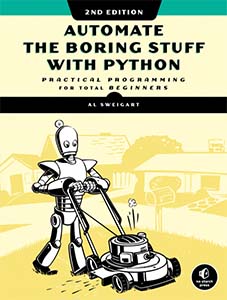
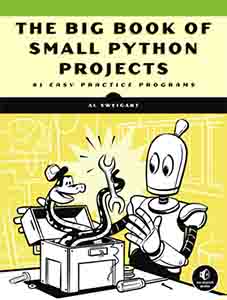
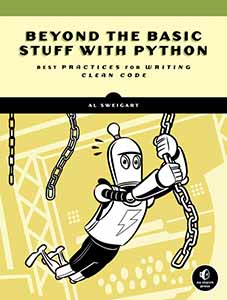
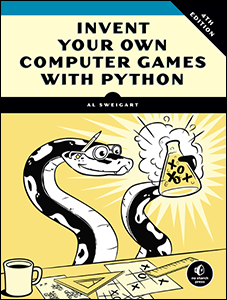
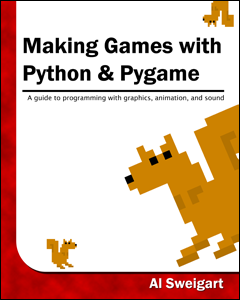
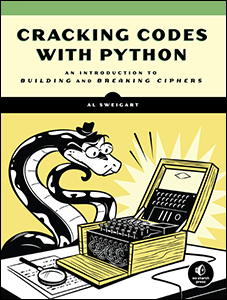

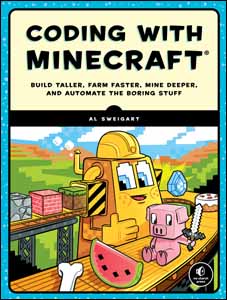
Use this link to get 70% off the Automate the Boring Stuff online video course.
Support me on Patreon









This chapter’s program tells a few jokes to the user and demonstrates more advanced ways to use strings with the print() function. Most of the games in this book will have simple text for input and output. The input is typed on the keyboard by the user, and the output is the text displayed on the screen.
You’ve already learned how to display simple text output with the print() function. Now let’s take a deeper look at how strings and print() work in Python.
Here’s what the user sees when they run the Jokes program:
What do you get when you cross a snowman with a vampire?
Frostbite!
What do dentists call an astronaut's cavity?
A black hole!
Knock knock.
Who's there?
Interrupting cow.
Interrupting cow wh-MOO!
Open a new file editor window by clicking File  New Window. In the blank window that appears, enter the source code and save it as jokes.py. Then run the program by pressing F5.
New Window. In the blank window that appears, enter the source code and save it as jokes.py. Then run the program by pressing F5.

If you get errors after entering this code, compare the code you typed to the book’s code with the online diff tool at https://www.nostarch.com/inventwithpython#diff.
jokes.py
1. print('What do you get when you cross a snowman with a vampire?')
2. input()
3. print('Frostbite!')
4. print()
5. print('What do dentists call an astronaut\'s cavity?')
6. input()
7. print('A black hole!')
8. print()
9. print('Knock knock.')
10. input()
11. print("Who's there?")
12. input()
13. print('Interrupting cow.')
14. input()
15. print('Interrupting cow wh', end='')
16. print('-MOO!')
Let’s start by looking at the first four lines of code:
1. print('What do you get when you cross a snowman with a vampire?')
2. input()
3. print('Frostbite!')
4. print()
Lines 1 and 3 use the print() function call to ask and give the answer to the first joke. You don’t want the user to immediately read the joke’s punchline, so there’s a call to the input() function after the first print() instance. The user will read the joke, press ENTER, and then read the punchline.
The user can still type in a string and press ENTER, but this returned string isn’t being stored in any variable. The program will just forget about it and move to the next line of code.
The last print() function call doesn’t have a string argument. This tells the program to just print a blank line. Blank lines are useful to keep the text from looking crowded.
Lines 5 to 8 print the question and answer to the next joke:
5. print('What do dentists call an astronaut\'s cavity?')
6. input()
7. print('A black hole!')
8. print()
On line 5, there’s a backslash right before the single quote: \'. (Note that \ is a backslash, and / is a forward slash.) This backslash tells you that the letter right after it is an escape character. An escape character lets you print special characters that are difficult or impossible to enter into the source code, such as the single quote in a string value that begins and ends with single quotes.
In this case, if we didn’t include the backslash, the single quote in astronaut\'s would be interpreted as the end of the string. But this quote needs to be part of the string. The escaped single quote tells Python that it should include the single quote in the string.
But what if you actually want to display a backslash?
Switch from your jokes.py program to the interactive shell and enter this print() statement:
>>> print('They flew away in a green\teal helicopter.')
They flew away in a green eal helicopter.
This instruction didn’t print a backslash because the t in teal was interpreted as an escape character since it came after a backslash. The \t simulates pressing TAB on your keyboard.
This line will give you the correct output:
>>> print('They flew away in a green\\teal helicopter.')
They flew away in a green\teal helicopter.
This way the \\ is a backslash character, and there is no \t to interpret as TAB.
Table 4-1 is a list of some escape characters in Python, including \n, which is the newline escape character that you have used before.
Escape character |
What is actually printed |
\\ |
Backslash (\) |
\' |
Single quote (') |
\" |
Double quote (") |
\n |
Newline |
\t |
Tab |
There are a few more escape characters in Python, but these are the characters you will most likely need for creating games.
While we’re still in the interactive shell, let’s take a closer look at quotes. Strings don’t always have to be between single quotes in Python. You can also put them between double quotes. These two lines print the same thing:
>>> print('Hello world')
Hello world
>>> print("Hello world")
Hello world
But you cannot mix quotes. This line will give you an error because it uses both quote types at once:
>>> print('Hello world")
SyntaxError: EOL while scanning single-quoted string
I like to use single quotes so I don’t have to hold down SHIFT to type them. They’re easier to type, and Python doesn’t care either way.
Also, note that just as you need the \' to have a single quote in a string surrounded by single quotes, you need the \" to have a double quote in a string surrounded by double quotes. Look at this example:
>>> print('I asked to borrow Abe\'s car for a week. He said, "Sure."')
I asked to borrow Abe's car for a week. He said, "Sure."
You use single quotes to surround the string, so you need to add a backslash before the single quote in Abe\'s. But the double quotes in "Sure." don’t need backslashes. The Python interpreter is smart enough to know that if a string starts with one type of quote, the other type of quote doesn’t mean the string is ending.
Now check out another example:
>>> print("She said, \"I can't believe you let them borrow your car.\"")
She said, "I can't believe you let them borrow your car."
The string is surrounded in double quotes, so you need to add backslashes for all of the double quotes within the string. You don’t need to escape the single quote in can't.
To summarize, in the single-quote strings, you don’t need to escape double quotes but do need to escape single quotes, and in the double-quote strings, you don’t need to escape single quotes but do need to escape double quotes.
Now let’s go back to jokes.py and take a look at lines 9 to 16:
9. print('Knock knock.')
10. input()
11. print("Who's there?")
12. input()
13. print('Interrupting cow.')
14. input()
15. print('Interrupting cow wh', end='')
16. print('-MOO!')
Did you notice the second argument in line 15’s print() function? Normally, print() adds a newline character to the end of the string it prints. This is why a blank print() function will just print a newline. But print() can optionally have a second parameter: end.
Remember that an argument is the value passed in a function call. The blank string passed to print() is called a keyword argument. The end in end='' is called a keyword parameter. To pass a keyword argument to this keyword parameter, you must type end= before it.
When we run this section of code, the output is
Knock knock.
Who's there?
Interrupting cow.
Interrupting cow wh-MOO!
Because we passed a blank string to the end parameter, the print() function will add a blank string instead of adding a newline. This is why '-MOO!' appears next to the previous line, instead of on its own line. There was no newline after the 'Interrupting cow wh' string was printed.
This chapter explores the different ways you can use the print() function. Escape characters are used for characters that are difficult to type into the code with the keyboard. If you want to use special characters in a string, you must use a backslash escape character, \, followed by another letter for the special character. For example, \n would be a newline. If your special character is a backslash itself, you use \\.
The print() function automatically appends a newline character to the end of a string. Most of the time, this is a helpful shortcut. But sometimes you don’t want a newline character. To change this, you can pass a blank string as the keyword argument for print()’s end keyword parameter. For example, to print spam to the screen without a newline character, you would call print('spam', end='').